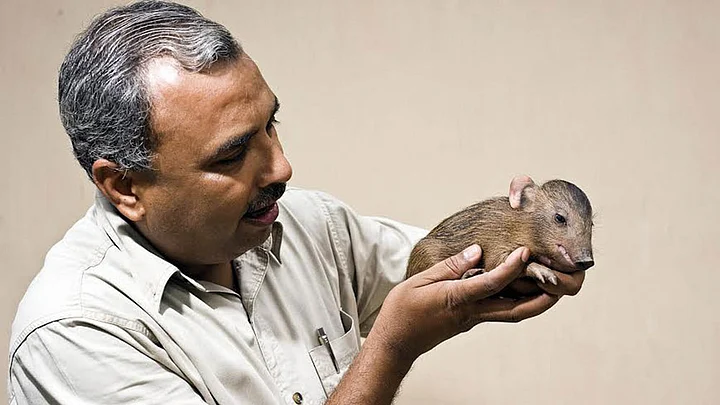Every winter, the swampy grasslands of Manas National Park beckon tourists for a sighting of the Royal Bengal Tiger, or the one-horned rhino, the poster boy of Assam Tourism and Assam Oil.
But not many come here to spot a pygmy hog, the rarest of rare and the smallest of the wild pig family on the planet, found only in this part of western Assam.
They are shy, small and sprint at incredible speed, making them hard to see. They don’t enjoy celebrity status like our awe-inspiring national animal or even recognised as a state symbol.
Yet it is the turn of the pygmy hog to steal – or, literally, hog – the limelight.
Dr Goutam Narayan, a field biologist who’s spent two decades researching this “evolutionary relic” and breeding them in captivity, won a rare honour from the International Union for Conservation of Nature (ICUN)’s Species Survival Commission recently: The Harry Messel Award for “saving a whole genus from extinction”.
“My highest moments are when I see the ‘hog signs’, signs of babies being born in the wild,” Narayan, who’s currently attending a workshop in the UK, said over the phone.
In 1995, Narayan set up the Pygmy Hog Research & Breeding Centre (PHRBC) in Basistha, near the state capital of Guwahati, with the help of the late William Oliver, a renowned pig expert. With financial support from the UK-based Durrell Wildlife Conservation Trust and the expertise of the Wild Pig Specialist Group, his non-profit organisation, EcoSystems-India, has been sparing no effort in restoring this critical species to its natural environment.
Pygmy hogs were once abundant – but have now vanished – in the Himalayan foothills called the Terai belt, a strip of marshland that separates India from Nepal. It is the site of intense human migration through the ages from both sides of the border.
Today, Nepal classifies pygmy hogs as “regionally extinct”, and they were thought to be extinct in India as well until the ‘70s, when a tea estate manager stationed in the park’s vicinity reportedly spotted a pair in a market, ready to go under a butcher’s knife.
But saving a species is tough work – tougher when the species in question is not exactly, as Narayan puts it, the “Cricket” of wildlife.
India’s wildlife management program is geared for preserving bigger animals – tigers, rhinos, elephants – in the belief that a broader protection focus across a wider territory would automatically save little creatures like, say, a pygmy hog or hispid hare. But that’s not always the case.
Often, unplanned burning of grassland inside a sanctuary causes senseless loss of pygmy hog habitat, which also happens to be the breeding ground of birds and home to swamp deer and wild buffaloes. Grasslands are usually set afire prior to the onset of rains to produce luxuriant shoots – the diet of many animals.
Sadly, India does not have a comprehensive grassland policy to protect the ecosystem of mini herbivores, and often, conflict in these blurred zones between habitation and forest pose a strain on conservation efforts.
Freeing up forest land for grazing over the decades – and, in the case of Assam, since the early part of the 20th century – means that human settlers have been inching closer and closer to wildlife habitats for grazing and fuel needs.
There’s also the problem of upstream water dams being built on the Manas river, which floods the grassland without warning – a threat to the ‘nests’ pygmy hogs painstakingly build by hooving out a shallow hole in the ground and covering it with a roof of grass leaves, the only pig species to do so.
Besides, all kinds of animals and not just pygmy hogs have been victims of unchecked trapping in this region affected by militancy.
Despite all odds, EcoSystems-India, in collaboration with the forest department, has managed to release 92 captive-born hogs in newer locales since 2008, in Sonai Rupai Sanctuary and Orang National Park in north Assam. Some handholding is required before their release; they live in ‘simulated’ wild environments until they’re ready to run free.
There are less than 300 pygmy hogs in the wild today. And tracking them isn’t easy.
First, they’re tiny in size: A full grown pigmy hog is one foot tall and weighs 7-9 kg – as much as a six-month-old human baby. Second, their drum-shaped body (and lack of a distinctive neck) means they can’t put on a radio collar like other animals do.
According to Parag Jyoti Deka, the conservation programme’s project manager, they’re constantly on the lookout for suitable tracking methods. They had tried using the “harness”, mini backpacks that the animal can wear with transmitters inside. This idea was dropped due to injury worries.
The team also tried fitting transmitters on a part of the ear; they discovered that the antennae easily broke as the animal run through grass thickets. In consultation with international experts, they even tried implanting them; radio transmitters surgically embedded under the animal’s skin.
Restoring a species is a time-consuming business. For instance, a lot of time is spent feeding dry observations into a computer. Or sitting motionless for hours atop a machan and staring at a still bog.
“It’s not wild adventure as you think,” says Narayan, who’s now 59. “Today, with Facebook and mobile phones, it’s even difficult to hold on to staff if there’s no Internet connectivity in the forest. They just leave.”
(Maitreyee Handique writes on India’s northeast and keeps a watch on labour, industrial safety and human rights issues.)
